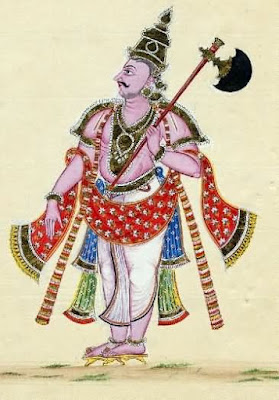 |
| Thiruvanchikulam Siva temple, Kodungallur, Kerala tourstokerala.orgorg |
Thiruvanchikulam Siva temple, Kodungallur in Thrissur district of Kerala was built during reign of Chera rulers in the 8th century. It is the only one Paadal Petra Sthalams in Kerala state glorified by the 7th century Tamil Saivite saints Nayanmars in their works Tevaram (a great Tamil canonical work). It is one among the 276 temples /Sthalams found mention in Tevaram. It was from here Sundara Murthi Nayanar, attained Mukthi (salvation) - reaching the holy feet of the lord in Kailash according to Periyapuranam, yet another a great Tamil canonical work. Here, Shiva, who is in the form of a lingam, is worshipped as Mahadeva and his consort Parvathi as Umadevi.
 |
| Thiruvanchikulam Siva temple, Kodungallur, Kerala en.wikipedia.org |
 |
| Thiruvanchikulam Siva temple, Kodungallur, Kerala.nativeplanet.com |
01. Saint Sundara Murthi Nayanar reached Kailash, Shiva's abode from here by sitting on an white elephant sent by Lord Shiva on Adi Swathi day (July/August) and he was followed on horse back by Seraman Perumal Nayanar. On his way to Kailash, Sundara Murthi Nayanar sang a Padhigam which was sent back to Thiruvanchikulam on his request.
 |
| Saivite saint Sudarar en.wikipedia.org |
Above image: Sundarar (Tamil Sundarar), also known affectionately as Tampiran Toḻan was an eighth-century poet and was one of the most prominent Nayanars, Tamil Saivite saints. He was a contemporary of Cheraman Perumal and Kotpuli Nayanar who is among the 63 Nayanmars. The Periya Puranam, which collects the legends of the Nayanars, starts and ends with him. The hymns of seventh volume of the Tirumurai, the twelve-volume compendium of the poetry of Tamil Shaiva Siddhanta, were composed by him.,........................................
02. The temple is associated with Chidambaram Sri Natraja temple in Tamil Nadu. It is one of the Pancha bootha Sthalams (five important elements of life) dedicated to sky.
Above image: The sixth avatar of Sri Vishnu in Hinduism. Born as a Brahmin, Parashurama carried traits of a Kshatriya and is often regarded as a Brahmin-Kshatriya. He, along with only Hanuman and Indrajita, is considered to be one of the very few Atimaharathi warriors ever born on the Earth. Like other incarnations of Vishnu, he was foretold to appear at a time when overwhelming evil prevailed on the earth....................................
03. It was at this holy shrine, Parasurama, an avatar of Vishnu, worshipped Shiva to atone for his sin of killing his mother Renuka.
04. Tamil Saivite poet, Sundaranar sang in praise of Mahadeva in ten verses in Tevaram, compiled as the Seventh Tirumurari. .It is a Paadal Petra Sthalam - temples that are revered in the verses of ''Tevaram.''
05. Shiva is the family god of the Cochin Royal Family -Perumpadapu Swaroopam after they came to power following the decline of Chera Empire.
06. The temple has amazing old mural paintings of Hindu mythology of beauty.
07. It is a protected monument under the administration of the ASI - the Archaeological Survey of India.
Mahodayapuram, the capital the Kulasekharas, existed around the temple and was protected by high fortifications on all sides connected with pathways and palaces. Tipu Sultan of Mysore was on a war expedition in Kerala during his hey day in the late 18th century. His violent army attacked and damaged the temple. The temple had fine copper roofing and extensive gold and jewelry collections. Tipu's army looted them and fled the place upon the arrival of the Travancore Army of Dalawa Keshavadas Pillai. The temple was rebuilt by Paliath Achan of Kochi/Perumpadappu Swaroopam.
 |
| Parasurama. findmessages.com |
03. It was at this holy shrine, Parasurama, an avatar of Vishnu, worshipped Shiva to atone for his sin of killing his mother Renuka.
04. Tamil Saivite poet, Sundaranar sang in praise of Mahadeva in ten verses in Tevaram, compiled as the Seventh Tirumurari. .It is a Paadal Petra Sthalam - temples that are revered in the verses of ''Tevaram.''
05. Shiva is the family god of the Cochin Royal Family -Perumpadapu Swaroopam after they came to power following the decline of Chera Empire.
06. The temple has amazing old mural paintings of Hindu mythology of beauty.
07. It is a protected monument under the administration of the ASI - the Archaeological Survey of India.
Mahodayapuram, the capital the Kulasekharas, existed around the temple and was protected by high fortifications on all sides connected with pathways and palaces. Tipu Sultan of Mysore was on a war expedition in Kerala during his hey day in the late 18th century. His violent army attacked and damaged the temple. The temple had fine copper roofing and extensive gold and jewelry collections. Tipu's army looted them and fled the place upon the arrival of the Travancore Army of Dalawa Keshavadas Pillai. The temple was rebuilt by Paliath Achan of Kochi/Perumpadappu Swaroopam.
The temple celebrates three annual festivals, of which the ten-day Vaikasipournami Brahmotsavam festival that falls in the Tamil month of Vaikasi (May - June) assumes much importance.
As usual, this temple built in Kerala style of architecture has entrance towers on all four sides. The sanctum/Srikovil is in the center of the fortified temple. The sanctum, the flagstaff and the entrance tower all fall on the same axial line, a common feature
in all Hindu temples regardless of architectural style. The
flagstaff - Dwajasthambam has images of Asthavidyesavara.
The images of Sundarar and Ceraman peruman are maintained at Bhagavathi temple near by and brought to the temple during
Svati festival during July - August. There are two temple tanks
in the second prathakshana path.
The temple administration is taken care of by the Thiruvanchikulam Devaswom under the Cochin Devaswom Board, Kodungallur town is also famous for Kodungallur Bhagawathy Temple and it is 3km from Thiruvanchikulam.
https://www.nativeplanet.com/travel-guide/thiruvanchikulam-mahadeva-temple-in-thrissur-003143.html
https://en.wikipedia.org/wiki/Thiruvanchikulam_Temple

.jfif)


.jfif)




